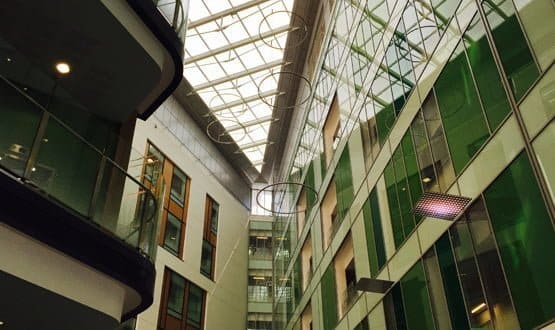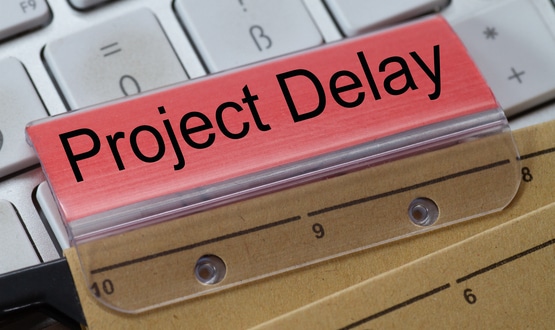Second time around
- 29 May 2015

The Brunel building at Southmead Hospital Bristol is a bright, airy and a surprisingly relaxing place to sit and watch the world go by.
Opened in May 2014, the development of the site it is still ongoing. This means there is a rather chaotic temporary main entrance while old buildings are knocked down to make way for a car park and green space. But while buses, taxis and ambulances remain log-jammed outside, inside all is calm.
Patients arrive into a six-storey atrium surrounded by glass and wood, where they scan the barcode on their appointment letter at one of the check-in kiosks.
From there, they are moved through various ‘gates’ via announcements on large digital screens. A patient may be directed to around three sub-waiting areas before reaching their clinic, meaning there are no large throngs of patients waiting anywhere at any one time.
Connected to wi-fi throughout, inpatients are soon going to get individual smart TVs, allowing them to watch catch-up TV and use other apps such as e-books free of charge.
The trust’s interim head of IT, Ward Priestman, is full of enthusiasm for the site; but says that the 21st century hospital now needs to be matched with a 21st century IT system.
Priestman is the last in a series of temporary CIOs at North Bristol since the last substantive holder of the post, Martin Bell, left in 2012. He will be replaced by Neil Darvill, currently director of informatics at St Helens and Knowsley Teaching Hospitals NHS Trust, who will take on the position permanently early next year.
“It does inspire you to think about technology,” Priestman says of the building. “It’s got robot porters, a fully digital pathology department, check-in kiosks and now we are getting rid of paper.
“My legacy, I hope, will be getting Lorenzo to go-live and electronic document management starting to be embedded.”
Getting it right this time
North Bristol will switch off its Cerner Millennium electronic patient record on 16 October and revert to paper for a few days before going live with Lorenzo on 18 October.
Clinical functionality will be rolled out over the following five months, with the aim of being 95% ‘paper-lite’ by next March.
While staff are enthusiastic about the potential of the new system, Priestman acknowledges that the trust is nervous about big IT go-lives. After all, its last big bang implementation went very publicly wrong.
When North Bristol implemented Cerner Millennium in December 2011, as part of the National Programme for IT, it triggered a series of issues in outpatients and theatres. Among other problems, patients were booked into non-existent appointment slots and appointment letters were not sent out.
An independent review of the deployment concluded that it went live with Millennium before the outpatient or theatre builds were complete. This sparked a “crisis” that took five months and £4.6m to resolve.
It took well over a year for the trust to get back to business-as-usual, and during this time all further roll-outs of the system were frozen.
The freeze remained in place while the trust went to tender for a new EPR to replace the national Cerner contract, which expires this October.
The IT team still had plenty to do, as the move from two hospitals into the one, new hospital necessitated an almost entirely newly configured Millennium system. However, North Bristol’s ambition of going paperless when it moved into the Brunel building has yet to become a reality.
The sight of woman pushing a large trolley of patient notes around is incongruous in this modern complex; and one the trust is committed to consigning to history with its implementation of Lorenzo.
Lorenzo to the rescue
“The big thing is about stopping generating paper which is [due to happen] with Lorenzo,” Priestman explains.
The first stage is replacing everything Cerner does already, while the second – called clinicals 1 – involves stopping paper generation by getting clinical staff to input information electronically.
Clinicals 1 project manager Ann-Marie Francis says around 70 clinicians have engaged so far to help her team map out how processes currently operate and how these can be streamlined in an electronic environment.
She explains that the key to connecting with clinicians is not to arrange a meeting on EPR and expect them to turn up, but to go out to them when and where they have time to chat.
“It’s often the same clinicians that are always interested in technology, so it’s about targeting those that haven’t had much to do from an IT perspective previously,” she says.
Francis cannot count how many meetings she has had in surgical theatres. She’s also attended numerous clinical governance meetings and other events at which she can connect with future users of the EPR.
“Because of past experience it’s made them even more determined to get it right this time so they are really engaged and helping to drive the project forward,” she says.
Her team started work with more than 500 data capture forms being used across the organisation. While everyone thinks their form is unique, close review showed they are in fact very similar – so the next step is agreeing unified forms that everyone can use.
“Moving from eight forms to two in ED wasn’t that difficult, it’s just about getting everyone to accept they are all capturing very similar information,” Francis says.
Desperate to do things differently
Priestman says clinicians need no persuasion that going digital is a good idea. “They are pushing me to say how can we do things quicker? They are desperate to do things differently and use IT in a way it should be used,” he says.
“There’s a massive amount of hunger from clinicians and the board around IT development.” Rather than make it in IT project, the EPR go-live has been embedded into the organisation.
The chief operating officer is the senior responsible officer for the core go-live and the medical director is SRO for the clinical implementation.
If the eyes of the trust are upon the EPR project, they are looking especially keenly at the data migration project. “If I look at what went wrong last time, most of the issues came from data migration,” says Priestman.
“So we’re taking a completely different approach with a massive amount of testing and evaluation in a way never done previously.
“What’s different for us is we have to transform the data. In Cerner we have a waiting list and in Lorenzo we have an access plan; they are the same thing, but the way the system handles them and the way the data is used is completely different.”
Around 22 million records have to be transferred from the BT data centre to CSC’s data centre and a four-person team is working on ensuring it goes smoothly. Rather than migrating the data in two or three big lots, North Bristol is doing lots of mini lots so it can be tested and any issues fixed quickly.
Staff will be trained according to their roles, rather than on the system and will be tested on their competency before being allowed to use the EPR.
“CSC have been great. They have been really, really helpful. They are desperate to make a success out of this – and we are desperate as well,” Priestman.
No more paper!
Another step on the trust’s digitisation journey is to get rid of the paper already circulating by implementing an electronic document management system, for which the trust is out to procurement. An EDM was planned for a go-live in 2014, but could not proceed when the business case failed to stack up.
“Re-utilisaiton of the revenue stream” rather than a massive capital investment means the figures now work with an estimated return on investment of £1.8million a year once implemented.
The trust will work on a ‘scan-on-demand’ policy and start scanning forward for clinics that tend to see the same patients multiple times a year. In this way it plans to scan most of the library over two to three years.
It has plans to do e-prescribing and, more pressingly, must replace its legacy maternity system. In both cases, it will assess the Lorenzo module against others in the market before making a decision.
Whatever systems are retained or replaced, Lorenzo will become the interface through which all patient information will be accessed. “The ambition the trust has is massive, but once you replace the core Cerner functionality, after that everything else comes in gradually. There’s lots of little changes,” Priestman says.
Clinicians are key
Practice development matron for North Bristol Andrea Scott is enthusiastic about the potential of using technology to release nurses’ time to care at the bedside.
She says a key part of building trust amongst clinical staff has been the ability to see and touch the Lorenzo system before it is installed.
“Our clinical staff will be involved in end to end testing so the people doing the job will be helping us test the system so there’s a lot more assurance this time that people can see it and people own it,” she explains.
“The system is easy for people to navigate, more like a web browser, so it’s much easier for staff to get their head around and understand.”
Scott is confident that the go-live will be a success and will transform the care clinicians can provide to patients.
“The people who make systems work are nurses doctors and allied health professionals. Electronic systems are only as good as the data put into them so staff have to want to put good data in there so staff engagement is vital,” she says.




